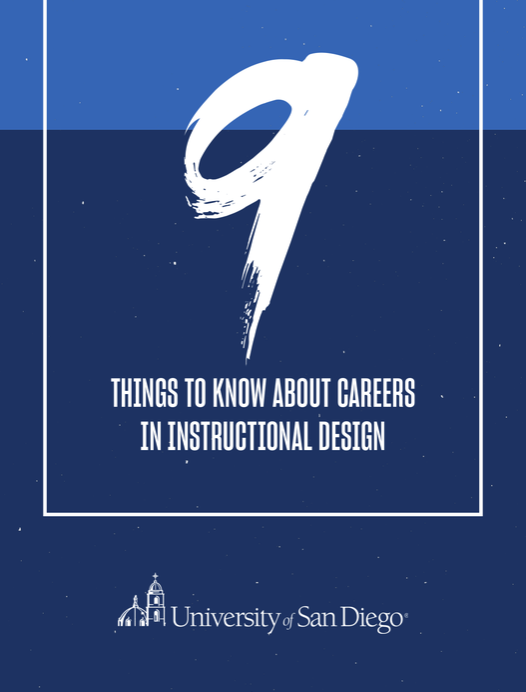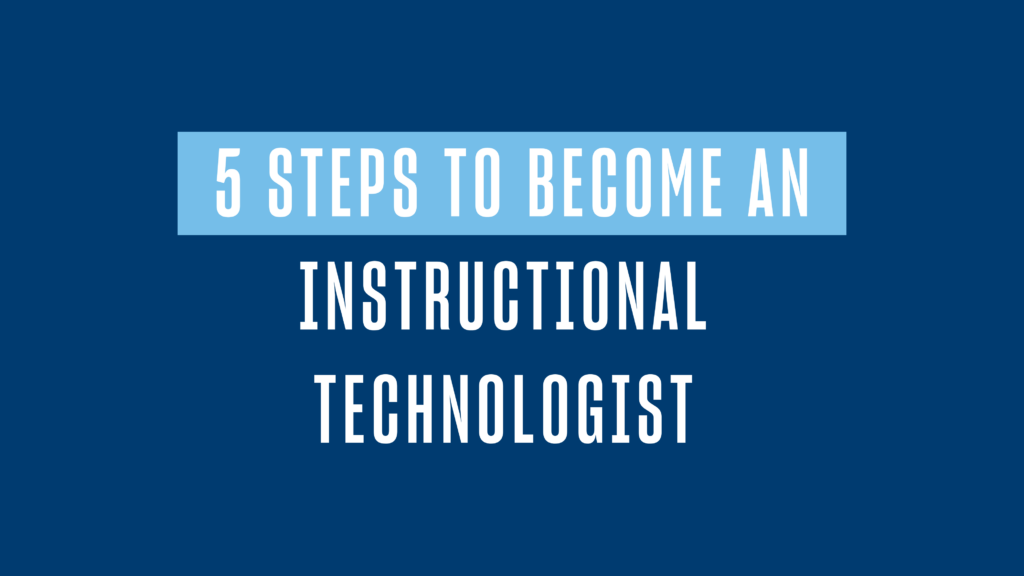If you’re interested in working in education and have an interest or talent in using technology to create dynamic learning experiences, consider training as an eLearning developer. Due to the ongoing adoption of remote learning and training, it’s a position that remains high in demand. Global Market Insights predicts that the North American market alone “will grow steadily through 2028 due to increasing investments in IT infrastructure.” Other geographic markets, such as India, Germany, and the Asia-Pacific region, are forecasted to experience even higher levels of growth in the eLearning industry.
It’s a career path full of opportunities, with jobs available in both education and private industry. It also comes with specific educational and skill requirements. If you’re interested in this exciting position, here’s what you need to know to become an eLearning Developer.
What Does an eLearning Developer Do?
As an eLearning Developer, you’re responsible for taking the blueprint of a course to produce an online program using eLearning tools, such as learning management systems (LMSs), eLearning authoring tools, and various learning technologies. An instructional designer creates the blueprint, which outlines the elements of the course, including the lessons, topics, activities, and assessments. You’ll develop and program the course — which can include making decisions about content organization and graphic design, producing interactive learning objects, and deciding which features make it easy for learners to engage with the content and navigate the course.
Additional responsibilities will depend on the industry you’re in and the size of the organization but can include:
- Building and maintaining websites to host the eLearning courses
- Determining the appropriate medium for course materials
- Researching new eLearning tools and making recommendations to stakeholders
- Providing training for other educators on course design and the use of technology
Differences Between eLearning Developers and Instructional Designers
Though sometimes the positions are considered interchangeable, both eLearning Developers and Instructional Designers have distinct responsibilities.
Instructional designers design the broad outlines of a course. They start by meeting with stakeholders and subject matter experts to determine the learning objectives, the desired skills or knowledge goals for the learners, the best pedagogical approach for instruction, and the means of assessment.
eLearning Developers review the instructional material and the recommendations of the instructional designer. Following the outline, they’ll often design a storyboard of the content and send it back to the instructional designer and other stakeholders for approval. The eLearning developer will take any storyboard feedback and combine all the course elements — including activities, navigation, interactions, and any required coding. After the course is developed, the instructional designer and subject matter expert will do a final quality assurance check before launching the course.
| Instructional Designer | eLearning Designer/Developer |
| Meets with stakeholders and SMEs Determines learning objectives Establishes learner goals Decides on pedagogical approach and means of assessment Builds course blueprint Reviews constructed course to provide feedback and approval | Creates a storyboard of the course Presents initial design for feedback Creates the course using eLearning development tools Develops and designs media, activities, navigation and other elements Presents final eLearning course for review and approval |
Both jobs are essential for creating eLearning courses and are considered to be two of the top careers in instructional design. For a more in-depth breakdown of how these two positions differ and collaborate, see our Instructional Designer vs. eLearning Developers [Career Comparison] blog post.
General eLearning Developer Education Requirements
To become an eLearning developer, you may need a bachelor’s or associate’s degree in instructional design, educational technology or a related technical field such as IT systems or computer science. Higher level positions may require a master’s degree from similar fields and/or a minimum of one year’s experience of eLearning development training or working as a designer.
Additional educational and experience requirements will vary according to each position, but could include:
- Knowledge of adult learning principles
- Mastery of instructional design models
- Experience as an instructor
- Specific computer programming or software certificates
- Experience in LMS administration
Top Skills for eLearning Developers
Aside from specific degrees, eLearning developer jobs also require a mix of technical and soft skills. If you’re hoping to stand out as a job candidate, here are the areas that you should develop as strengths.
Hard/Technical Skills
- UX best practices — Good user experience (UX) design is fundamental in creating content that is understandable, accessible and effective. An eLearning developer always has to keep the end-users in mind to create intuitive layouts, clear instructions and simple presentations. It’s important to remember that modern best practices for UX design must also account for mobile devices.
- Familiarity with eLearning development tools — The main tools of eLearning developers are the content authoring software used to create digital courses. While most are designed with “What You See Is What You Get” (WYSIWYG) user interfaces, you’ll need some programming skills to take full advantage of certain features and functions. Most products provide a library of assets that work for desktop, tablets and mobile devices. It’s recommended that you familiarize yourself with the more popular and widely used programs, such as Articulate 360.
- Graphic design and multimedia editing capabilities — Visual design skills are essential, as you’ll need to create graphic elements for the course itself. You should also have a demonstrated understanding of the basic principles of graphic design, such as balance, contrast and white space. You’ll also need to be able to work with audio and video, which includes editing content to remove noise, adjust the sound, insert graphics and other objects and cut everything together. Accordingly, you should be comfortable working with programs like the Adobe Creative Cloud, Camtasia and Audacity.
- Knowledge of SCORM technical standards — SCORM, or Sharable Content Object Reference Model, are international technical standards for eLearning products. Essentially, these are guidelines on how to write code so that eLearning content and learning management systems work together. As an eLearning developer you should be capable of using SCORM-compliant authoring tools to create and publish courses.
- Familiarity with LMSs — Learning management systems are where eLearning courses are published, so you’ll need to be skilled in working with them. Familiarize yourself with the top LMS providers. Forbes has a list of the best 2023 LMS products for education (Blackboard, Canvas, Moodle) and businesses (Absorb, TalentLMS, Decebo).
Soft Skills
- Strong written and verbal communication — You’ll need to explain complex topics in a simple and straightforward manner to effectively engage learners. Digital, asynchronous communication has different nuances from direct or verbal communication, so it helps to have a portfolio of created content to showcase your design and communication skills. You’ll also need to clearly and directly communicate with instructional designers, SMEs, developers, and other professionals regularly.
- Adaptability and flexibility — Good project management is more than just having a course development plan. You must also factor in time for feedback and edits. Because technology continually advances, programs you’re comfortable using may evolve or become obsolete within a few years. It helps you professionally if you’re quick to adjust to new programs and comfortable working on different platforms.
- Collaboration with others — You’re a critical part of a cross-functional team, the link between the instructional designers who create courses and the instructors who facilitate them. To develop courses that meet the needs of learners, you have to be comfortable providing and receiving feedback. You’re considered the subject matter expert for the eLearning development process, so your team will expect you to provide recommendations and insight regarding best practices.
What Are the Salary Ranges for eLearning Developers?
Like any industry, the difference in an eLearning developer’s salary will depend on a host of factors, including your experience, the industry in which you work and your location. For example, ZipRecruiter shows that, in 2023, the annual salary of an eLearning Developer in San Francisco will be 13.8% higher than the national average of $73,941. Salary.com estimates a base salary ranging from $69,780 to $85,580.
The salary of an eLearning designer compares favorably to other related positions in education and training. According to Salary.com, as of 2023 you can expect the following salary ranges for comparative careers in training and education:
- Instructional Designer: $69,780-$85,580
- Corporate Trainer: $52,382-$67,876
- Project Manager: $63,178-$80,341
- Instructional Technologist: $48,904 and $88,534
Steps to Becoming an eLearning Developer
If eLearning development sounds like the career for you, here are the recommended steps you should be taking.
- Earn your degree — You’ll need at least an associate’s degree, and most positions will require a bachelor’s degree in a related field. Look for programs that offer degrees in instructional design, educational technology, communication or multimedia design.
- Develop your technical skills — Even if you’re already taking classes, consider earning additional certifications in specific technologies or software, such as Articulate Storyline. Enroll in courses or workshops that teach the latest content authoring tools, LMSs or multimedia design software.
- Gain experience — Even for in-demand jobs, it can be hard to find that first opportunity. Consider applying to internships or entry-level positions in instructional design, training or education positions. Look for educational programs that allow you to develop courses and create personal portfolios. The more you can work on instructional design projects, the more you can showcase your skills.
- Continue learning — If you’re interested in this career, then understand it’s a commitment to continual learning. Get in the habit of reading industry publications and design blogs. Join professional organizations or find ways to connect with other developers. Networking can keep you up infomed on the latest tools and technologies and could open doors to new opportunities.
If you’d like to learn more about eLearning design principles or the learning design process in general, consider exploring the online Master of Science in Learning Design and Technology at the University of San Diego. This innovative master’s program is designed to meet the needs of aspiring learning designers who work with modern digital technologies.




![What Does an Instructional Designer Do? [Career Info & FAQs]](https://onlinedegrees.sandiego.edu/wp-content/uploads/2021/08/ldt_blog_whatdoesiddo-1024x576.png)
